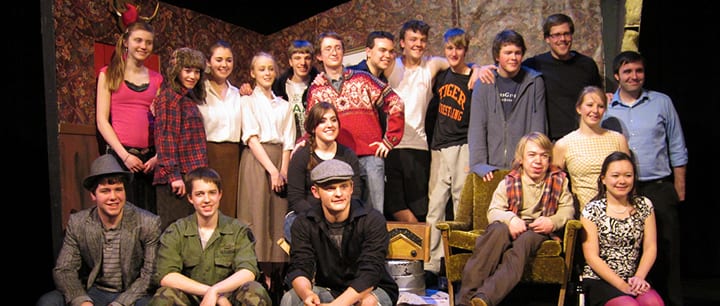 A big part of becoming an actor is exploring various acting styles, and figuring out where your strengths are. Read on to learn about some of the different types, courtesy of Brooklyn, NY teacher Liz T...
A big part of becoming an actor is exploring various acting styles, and figuring out where your strengths are. Read on to learn about some of the different types, courtesy of Brooklyn, NY teacher Liz T...
When exploring the world of acting, it is essential to try out different styles in order to improve your skills. although some methodologies may speak to you more than others, it is necessary to have a well-rounded understanding of the field.
Keep reading to learn about four popular acting styles and how they can help take your career to the next level!
What Are the Types of Acting?
Depending on who you ask or what kind of setting you are performing in, there are four main styles of acting: comedy, tragedy, drama, and musical theater:
- Comedy is all about timing and delivery. The best comedians are able to make even the most ordinary situations seem hilariously funny.
- Tragedy requires a different kind of skillset. To be successful in tragedy, actors must be able to convey a deep sense of despair and loss.
- Drama is all about realism. The best actors are able to completely immerse themselves in their characters and convincingly portray the highs and lows of human emotion.
- Musical theater is a unique blend of acting, singing, and dancing. It takes a truly special talent to be able to belt out a tune while performing complex choreography.
Regardless of which type of acting you’re interested in pursuing, there’s sure to be a role that’s perfect for you. So what are you waiting for? Start auditioning today and ask your acting coach for tips on how to make the most of your performance, like what you see in the video below:
https://www.youtube.com/watch?v=FC2nCacQEZg
4 Different Acting Styles to Practice
If you’re an actor starting out in your training, get ready to plunge into a variety of acting styles! As an actor you should familiarize yourself with all of the different acting styles at first, and then choose one to focus on. It is best to be well-rounded and to know the methods and skills used for each style of acting, and then see which style comes natural to you!
Acting Styles in Film
This includes anything that is being filmed, such as movies, TV, webisodes, commercials, reality shows, hosting, and so on. Acting for film requires different techniques than you would use when performing on stage (which I will talk about in my next topic). Everything seen and heard on TV is different, when it comes down to the actual filming process of it. Most often you will not be in front of a live audience, but will perhaps be doing a scene with a partner. The scene may be shot by the director a thousand times before moving on, so patience and stamina are a must. You have to make the scene look fresh each time you film it, because you never know which take they are going to use! Acting for film requires you to go more into depth, while paying attention to your facial expressions in front of the camera and the volume of your speaking voice.
Acting Styles in Theatre
Where in acting for film you do not have to project your voice as much, in theater you have to work on projecting your voice loud enough so that the entire theater can hear you without having to use a microphone! In theater, you may be doing the same show eight times a week, and again have to keep it fresh for the audience each time, as it is a brand new performance. On stage, you also have to be conscious of your movement, your surroundings, and how you interact with the other cast members, scenery, props, and so on. You have to be able to think on your feet if something doesn’t go exactly right on stage, and always stay in character. Unfortunately during a live show there is no “going back” – you can’t re-shoot like you can in film, so you you must move forward!
Classical Acting
Classical acting consists of mostly dramatic works, including plays, works by Shakespeare, monologues, and some comedy dating back to 1500 B.C. Classical acting is still appreciated today, and requires lots of training to perfect. To go more in depth with classical acting, I recommend diving into Shakespeare and other serious playwrights such as Eugene O’Neill, Tennessee Williams, Arthur Miller, and Neil Simon. Work on those dramatic monologues, and perfect your delivery, accents, and scene work with props. Classical acting is not for the “wannabe” actor – it is taken very seriously and is highly respected. Most dramas took place over in Europe, so you’ll also want to become familiar with different times and points in history.
Improvisation
This is one of the more contemporary acting styles, which requires a lot of imagination and creativity! Based on having fun and letting loose, improv troupes are quite popular today, especially among the 20- to 30-year-old range. Improv training consists of learning silly acting games or acting out skits and scenarios, and is usually performed in front of a live audience on stage. If you’re interested in learning more about this acting style, try watching Whose Line Is It Anyway? and Saturday Night Live for inspiration! You can also take improv classes or find an acting teacher to help you improve your skills. With improv, you must be confident enough to perform on your own, but you also need to have the skills to perform in a group and work with your teammates!
What Are the 8 Acting Methods?
Every great actor has a process, a series of steps they take to prepare for a role and engage with the material. And while there is no one “right” way to approach acting, there are certain methods that have proven themselves time and again to be highly effective. Below, we’ll explore eight of the most popular and influential acting methods being used today.
1. Stanislavski’s Method
Arguably the most famous and influential of all the acting methods, Stanislavski’s method was developed by Russian director and actor Constantin Stanislavski in the early 20th century. It’s a system that emphasizes emotionally truthful performances, achieved through a process of active analysis and imagination. actors who use this method often seek to create detailed backstories for their characters, so they can better understand their motivations and emotions.
2. The Meisner Technique
The Meisner technique was developed by American actor and teacher Sanford Meisner in the 1930s. It’s built around the idea of “repetition” – namely, that the best way to really get inside a character’s skin is to repeat their actions over and over again until they become second nature. This technique requires a lot of improv work between actors, as they feed off each other’s energy to create realistic scenes.
3. Violent Integration
Violent Integration is a relatively newacting method created by Tim Phillips in 2006. It’s based on the premise that violence is a part of life, and therefore should be a part of our art as well. This approach encourages actors to access their own experiences with violence (whether it be physical, emotional, or mental) in order to bring a more authentic edge to their performance. Warning: this technique is not for everyone!
4. Chekhov Technique
The Chekhov technique was developed by legendary Russian director and actor Michael Chekhov in the early 20th century. It’s an approach that relies heavily on sensory work and images to help actors connect with their characters on a deeper level. One key exercise Chekhov taught was what he called “psychologicalgestures” – using your body language to express your character’s internal state, rather than just their external actions..
5. Strasberg Method
The Strasberg method is another hugely influential acting technique, created by Lee Strasberg in the 1940s/1950s. It shares many similarities with Stanislavski’s method (In fact, Strasberg was one of Stanislavski’s students), but emphasizes “sense memory” – using your own past experiences to inform your performance in the present moment. This can be a powerful tool for connecting with difficult material, but can also be tricky to master..
6. Uta Hagen Technique
The Uta Hagen technique was created by renowned German-born actress Uta Hagen in the 1970s. It focuses on bringing honesty and spontaneity to every performance, through detailed preparation and living fully in the moment onstage. This technique has been taught at some of the top drama schools around the world, including Juilliard and Yale.
7. The Stella Adler Technique
Created by Stella Adler, this technique is based on the idea that improvising is key to good acting. Actors who use this method often do extensive research on their characters and their backstories before they even step on set or stage. That way, they’re able to make spontaneous choices that feel organic and true to their characters.
8.The Method Acting Technique
The method acting technique is similar to the Stanislavski method in that it also relies on emotional memory. However, there are some key differences between these two methods. Method acting was developed by American actor and director Lee Strasberg in the 1950s. Unlike the Stanislavski method, which focuses on inner emotions, method acting focuses on outer emotions or what can be seen and heard by others. This approach can help actors to better understand their characters and create truthful performances.
How Do I Find My Acting Style?
Many actors find their niche early on and stick to it throughout their careers. They may play the same type of role over and over or be drawn to similar material. And while there’s nothing wrong with this, it can be limiting. It’s important to experiment and find what works for you.
The best way to do this is by trying new things. If you’re used to comedy, try drama. If you’re used to period pieces, try a contemporary piece.
By pushing yourself outside of your comfort zone, you’ll be able to discover new strengths and weaknesses. You may also find that you enjoy acting in a completely different way than you originally thought.
So don’t be afraid to explore. The more you experiment, the closer you’ll get to finding your acting style.
What Are Acting Styles You Should Practice?
Each actor is called to a different acting style, whether it be for film, TV, or in a classical or improvisational role. I encourage you to study each, ask your acting coach for tips, and see which of the acting styles you enjoy the most! Best of luck!
 Liz T. teaches singing, acting, and music lessons in Brooklyn, NY, as well as online. She is a graduate of the Berklee College of Music with a B.M in Vocal performance and currently performs/teaches all styles of music including Musical Theater, Classical, Jazz, Rock, Pop, R&B, and Country. Learn more about Liz here!
Liz T. teaches singing, acting, and music lessons in Brooklyn, NY, as well as online. She is a graduate of the Berklee College of Music with a B.M in Vocal performance and currently performs/teaches all styles of music including Musical Theater, Classical, Jazz, Rock, Pop, R&B, and Country. Learn more about Liz here!
 Photo by Nic’s events
Photo by Nic’s events
Suzy S.
